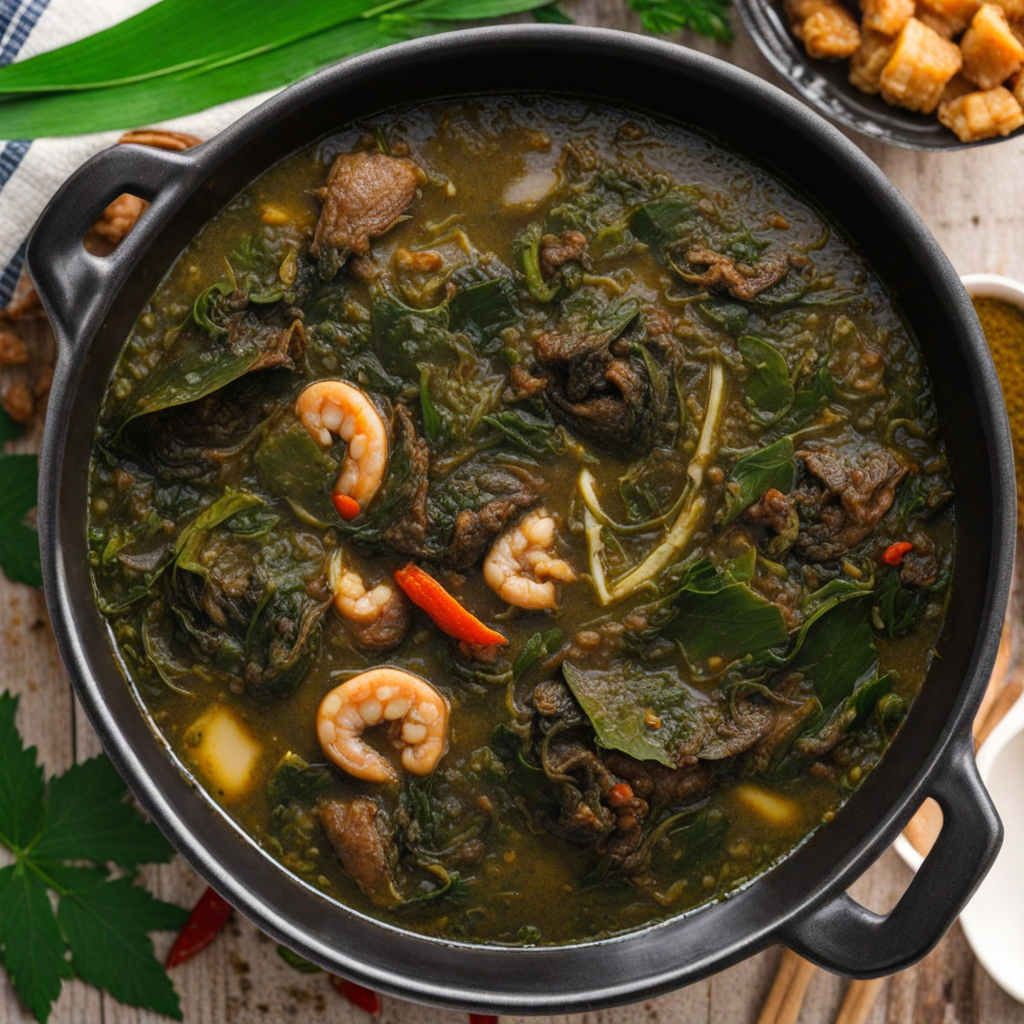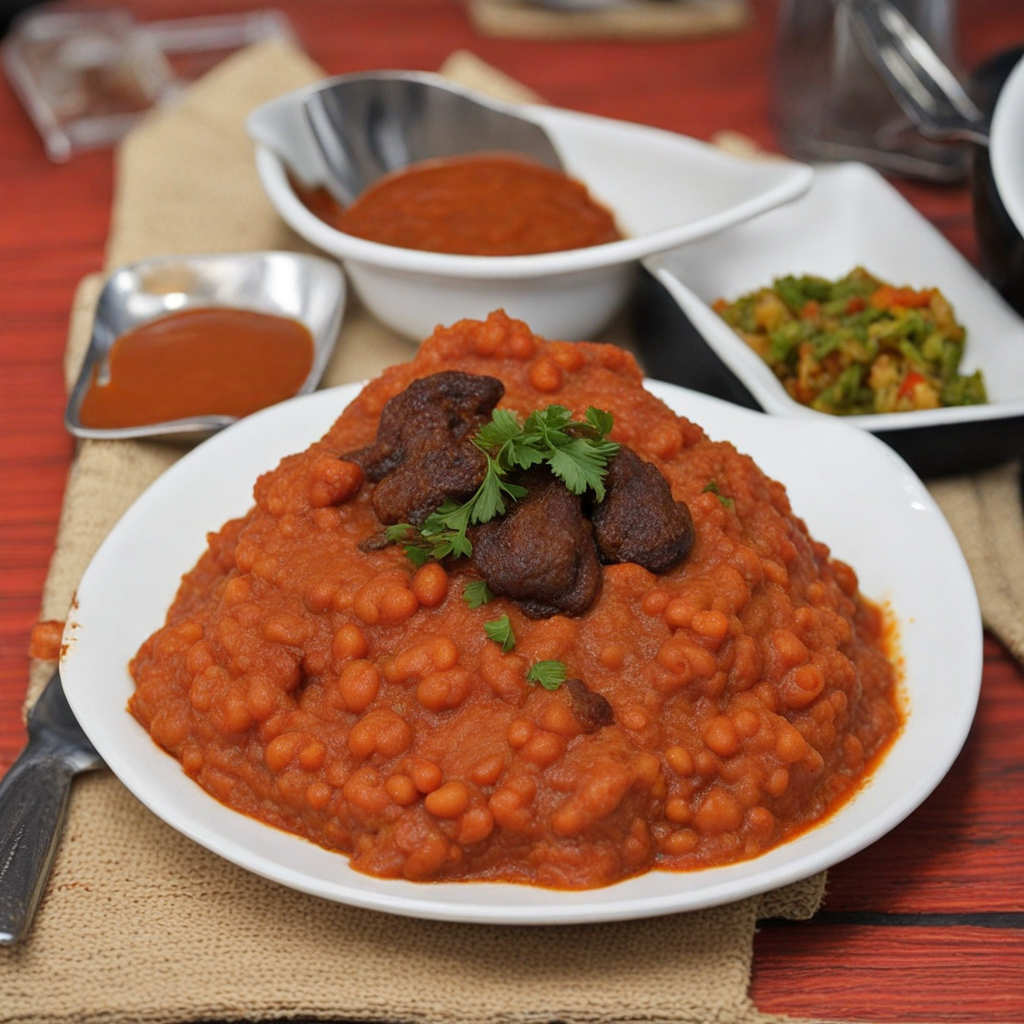Afang Soup
Afang Soup is a rich and hearty dish hailing from Nigeria, particularly popular among the Efik people of Cross River State. This vibrant soup is primarily made with Afang leaves, also known as Okazi, and waterleaf, which give it a unique earthy flavor and a vivid green color. The combination of these two leafy vegetables creates a nutrient-packed base that is both delicious and wholesome, bringing a freshness that beautifully complements the other ingredients. The leaves are finely chopped, allowing them to meld seamlessly with the soup's other components, creating a thick, luscious texture that is as inviting as it is satisfying. One of the standout features of Afang Soup is its depth of flavor, achieved through the use of varied proteins. Traditionally, the soup is made with assorted meats such as goat, beef, and fish, which are simmered together to infuse the broth with a rich, savory essence. The addition of ground crayfish and locust beans enhances the umami profile, while palm oil lends a luxurious, velvety finish to the dish. This harmonious blend of flavors and textures makes every spoonful a delightful experience, whether enjoyed alone or with a starchy side like pounded yam or fufu. Afang Soup is not just a feast for the palate, but also a celebration of communal dining. Often enjoyed during special occasions and gatherings, it brings friends and family together, making it a cherished part of Nigerian culture. The vibrant colors and aromatic scents wafting from the pot create an inviting atmosphere, drawing everyone to the table. As you explore the essence of Afang Soup, you'll discover a dish that embodies the warmth of Nigerian hospitality and the rich culinary traditions that have been passed down through generations.
How It Became This Dish
The Rich Heritage of Afang Soup: A Culinary Delight from Nigeria Afang Soup, a delicious and nutritious dish, is an emblem of the culinary heritage of the Efik and Ibibio people of southeastern Nigeria. Known for its rich flavor and vibrant green color, this soup is made primarily from Afang leaves (also known as Okazi leaves) and waterleaf. It is a dish that not only signifies the gastronomic traditions of the region but also embodies the cultural identity and communal values of the people who prepare and enjoy it. #### Origins and Ingredients The origins of Afang Soup can be traced back to the Efik and Ibibio ethnic groups, who inhabit the coastal regions of Akwa Ibom and Cross River states in Nigeria. The soup is traditionally associated with the Efik people, who are renowned for their culinary prowess and elaborate feasts. Afang leaves, the primary vegetable in the soup, are indigenous to this region, thriving in the humid tropical climate. The leaves are known for their tender texture and slightly bitter taste, which balances beautifully with the other ingredients. Waterleaf (Talinum triangulare), another essential component, is also native to the area. Its succulent leaves have a milder flavor that complements the more robust taste of Afang. The soup is typically enriched with a variety of proteins, including fish, meat (often goat or beef), and sometimes snails. The combination of these ingredients creates a dish that is not only flavorful but also packed with nutrients. #### Cultural Significance Afang Soup holds significant cultural value in the Efik and Ibibio communities. It is often served during special occasions, such as weddings, traditional ceremonies, and festivals, symbolizing hospitality, unity, and abundance. The preparation and sharing of Afang Soup are communal activities, reinforcing social bonds and cultural traditions. It is not uncommon for families to gather together, with each member contributing to the cooking process, whether by harvesting the vegetables, preparing the meat, or stirring the pot. In addition to its role in celebrations, Afang Soup also serves as a marker of identity. For the Efik and Ibibio people, the soup is a source of pride, reflecting their agricultural heritage and deep connection to the land. It encapsulates the values of communal living, as meals are often shared among family and friends, emphasizing the importance of togetherness. #### Evolution Over Time The evolution of Afang Soup mirrors the broader changes in Nigerian society and the culinary landscape of the country. Historically, the soup was prepared using traditional methods, with fresh, local ingredients sourced from nearby farms and markets. Over time, the globalization of food has introduced new ingredients and cooking techniques, leading to variations of the traditional recipe. The 20th century saw a shift in dietary habits, with urbanization and modernization affecting how people prepare and consume food. In cities, where access to fresh produce might be limited, some cooks began to rely on frozen or packaged ingredients. Additionally, the rise of fast food and convenience meals has influenced the way younger generations approach traditional dishes like Afang Soup. However, despite these changes, many families continue to uphold the traditional methods of preparation and cooking, ensuring that the essence of Afang Soup remains intact. In recent years, there has been a resurgence of interest in traditional Nigerian cuisine, fueled by the global food movement that seeks authentic culinary experiences. Chefs and home cooks alike have embraced Afang Soup, showcasing it in restaurants and food festivals both in Nigeria and abroad. This renewed attention has sparked a wave of innovation, with some chefs experimenting with fusion recipes that incorporate international flavors while maintaining the core of Afang Soup. #### Nutritional Aspects Beyond its cultural significance and delicious taste, Afang Soup is also recognized for its nutritional benefits. The Afang and waterleaf are rich in vitamins, minerals, and antioxidants, contributing to a balanced diet. The soup is often high in protein due to the inclusion of various meats and fish, making it a hearty meal that provides essential nutrients. In addition to its health benefits, the preparation of Afang Soup can be a therapeutic process. The act of cooking, particularly in a communal setting, fosters a sense of well-being and connection, allowing individuals to bond over shared experiences and stories. This aspect of cooking can be particularly important in a world that often feels disconnected, as it brings people together to celebrate their heritage and culinary traditions. #### Modern Interpretations With the rise of social media and food blogging, Afang Soup has gained popularity beyond its traditional borders. Food enthusiasts and influencers are sharing their versions of the dish, showcasing its versatility and adaptability. Some variations include the use of alternative proteins, such as chicken or plant-based options, catering to diverse dietary preferences. Furthermore, the presentation of Afang Soup has evolved, with chefs experimenting with plating techniques that highlight its vibrant colors and textures. Despite these modern interpretations, the heart of Afang Soup remains the same. It continues to serve as a cultural touchstone for the Efik and Ibibio people, preserving their culinary heritage while embracing contemporary influences. The soup stands as a testament to the resilience of traditional foods in the face of globalization and changing dietary habits. Conclusion In conclusion, Afang Soup is more than just a dish; it is a narrative woven into the fabric of Nigerian culture, carrying the stories of generations. Its origins in the Efik and Ibibio communities highlight the importance of local ingredients and communal cooking practices. As it evolves, Afang Soup continues to foster connections among people, celebrating heritage while embracing modernity. Whether enjoyed at a festive gathering or a quiet family dinner, Afang Soup remains a beloved symbol of identity, unity, and the rich culinary traditions of Nigeria.
You may like
Discover local flavors from Nigeria







